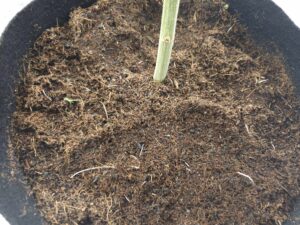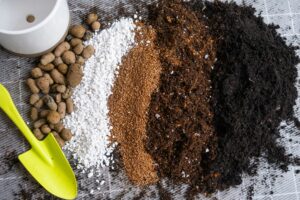
Imagine a world where cannabis plants thrive in a natural paradise, nurtured by organic soil, pure rainwater, and sunlight. This is organic cannabis cultivation, where nature leads and synthetic chemicals are left behind.
As eco-conscious growers, we focus on purity and sustainability. Organic growing is about more than avoiding chemicals—it’s about creating a healthy ecosystem. Using living soil, beneficial microbes, and compost teas, we help plants flourish naturally.
Starting with organic methods might seem challenging, but with some knowledge and passion, it becomes second nature. Whether you’re experienced or just beginning, join us in growing clean, potent cannabis in a way that honors Mother Nature.
Ready to cultivate a thriving garden? Let’s dive in!
Table of Contents
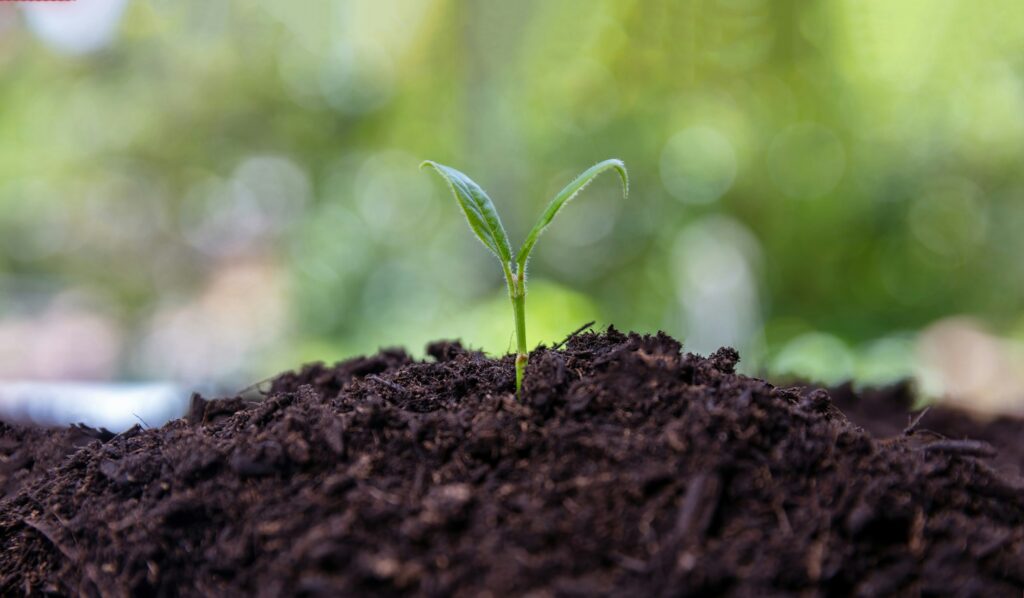
The Magic of Living Soil
In organic cannabis cultivation, living soil is the foundation that supports the entire garden’s vitality. Think of it as a bustling city beneath the surface, full of microorganisms that each play a vital role in maintaining the ecosystem’s health and productivity. This dynamic entity is much more than just dirt; it’s a living, breathing community essential for plant growth and sustainability.
The Life Within: A Microbial Metropolis
- The Cast of Characters: In this underground metropolis, bacteria, fungi, nematodes, and earthworms are the main characters, each contributing their unique skills to the community. They break down organic matter, convert nutrients into plant-available forms, and protect against pathogens.
- Symbiotic Relationships: Picture the mycorrhizal fungi, which form alliances with cannabis roots, extending their network and effectively increasing the plant’s access to water and nutrients. It’s like having a buddy system that ensures everyone gets to enjoy the party essentials.
Crafting the Perfect Environment
- Organic Matter is King: The key to a thriving living soil is the abundance of organic matter. Compost, aged manure, and leaf mold are like the finest hors d’oeuvres, providing the necessary nutrients and fostering microbial diversity.
- A Balancing Act: Maintaining the right balance of moisture, aeration, and nutrient levels is akin to being a great party host. You want to ensure every guest is happy, comfortable, and well-fed.
The Benefits: More Than Just Growth
- Enhanced Nutrient Uptake: Plants grown in living soil have access to a balanced diet, optimized for their growth and development. It’s organic cannabis cultivation at its finest, where plants don’t just grow; they thrive.
- Natural Disease and Pest Resistance: Healthy soil equals healthy plants. Like a well-oiled immune system, a vibrant soil community can protect cannabis from common pests and diseases without the need for synthetic chemicals.
- Environmental Stewardship: By nurturing living soil, we’re not just growing cannabis; we’re contributing to the health of our planet. Organic matter sequesters carbon, and the no-till practices commonly used in living soil cultivation help preserve soil structure and biodiversity.
Living soil is the cornerstone of organic cannabis cultivation, a testament to the power of working with nature rather than against it. By understanding and nurturing this complex ecosystem, we set the stage for growing cannabis that’s not only potent and flavorful but also sustainable and environmentally friendly.
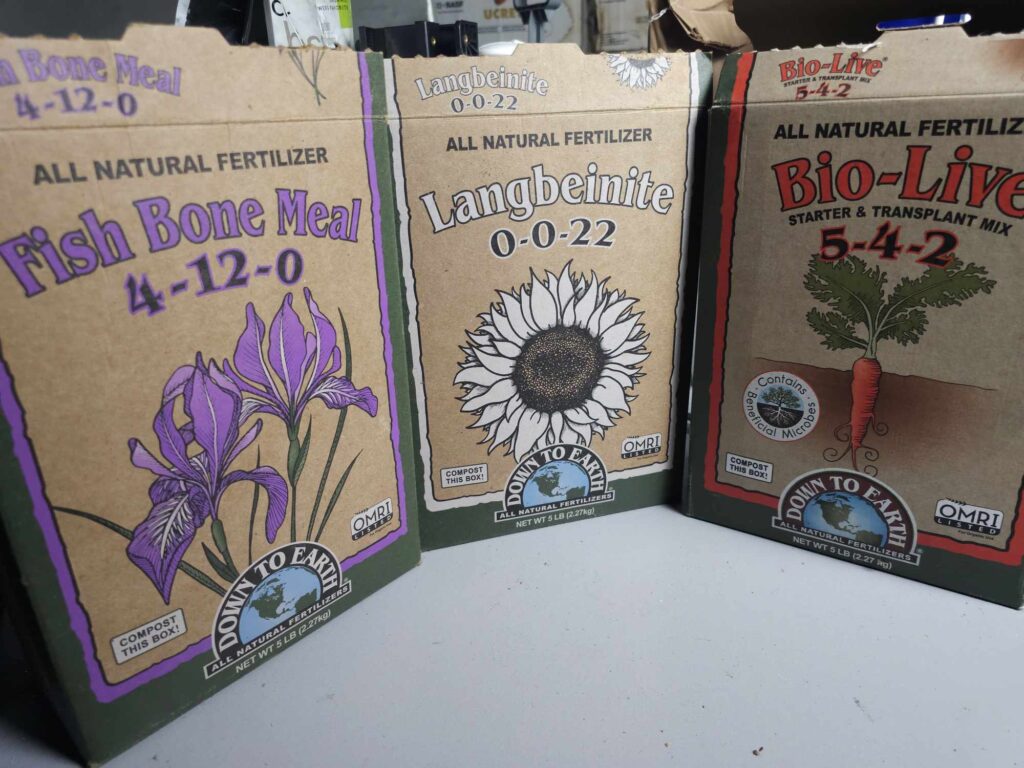
Nourishing Growth: The Organic Buffet
In the realm of organic cannabis, synthetic fertilizers are firmly off the guest list. Instead, we invite a more refined selection of natural nutrient sources to the table, each offering a slow-release feast that ensures our plants grow strong and healthy, all while maintaining the integrity of our living soil.
A Gourmet Feast for Plants
- Bone Meal and Blood Meal: Rich in phosphorus and nitrogen, these amendments are like the protein-packed main course, essential for root and foliage development.
- Fish Emulsion and Seaweed Extracts: Consider these the ocean’s gift to your garden, brimming with micronutrients and growth hormones that act as a vitality elixir for your plants.
- Guano: Bat or seabird guano is the secret spice, offering a potent mix of nitrogen, phosphorus, and potassium to rev up flowering and fruiting.
The Art of Composting
- Turning Waste into Gold: Composting is the alchemical process of transforming kitchen scraps, yard waste, and other organic matter into nutrient-rich gold for your garden. It’s the ultimate recycling project, with a pinch of magic.
- Compost Tea: Brewing compost tea is like concocting a fine wine for your plants. This nutrient-rich elixir, teeming with beneficial microorganisms, can be applied directly to the soil or as a foliar spray, giving your plants a direct infusion of vitality.
The pH Balance Dance
Maintaining the pH balance in organic cannabis cultivation is less about strict control and more about the harmonious dance of elements. Organic nutrients and amendments contribute to a self-regulating ecosystem where pH levels naturally tend toward the ideal range for cannabis growth.
- The Importance of Being Neutral: Cannabis thrives in slightly acidic to neutral soil (pH 6.0-7.0). In the organic buffet, the diverse menu of nutrients helps buffer the soil, keeping pH fluctuations in check.
- A Test of Time: Regular soil testing is akin to checking the pulse of your garden’s health, ensuring the pH remains in the sweet spot for optimal nutrient uptake.
Why Organic Nutrients?
- Slow and Steady Wins the Race: Unlike synthetic fertilizers, organic nutrients are released slowly, providing a steady diet that supports sustained growth without the risk of nutrient burn or leaching.
- Promoting Soil Life: Every organic addition is not just feeding the plant but enriching the soil’s microbial life, fostering a healthy garden ecosystem.
- The Taste of Purity: Organic cannabis is often lauded for its superior taste and aroma, a direct result of the rich, natural nutrient sources that enhance the plant’s terpene profile.
Feeding your cannabis plants with organic nutrients isn’t just a choice; it’s a dedication to quality and sustainability. We’re not just gardeners but gourmet chefs, crafting a nutrient-rich menu for our plants.
In organic pest and disease management, the goal is harmony and balance, not combat. We use natural strategies like beneficial insects and organic remedies to protect our plants. This eco-friendly approach creates a nurturing and healthy environment for cannabis cultivation, ensuring a thriving garden without harmful chemicals.
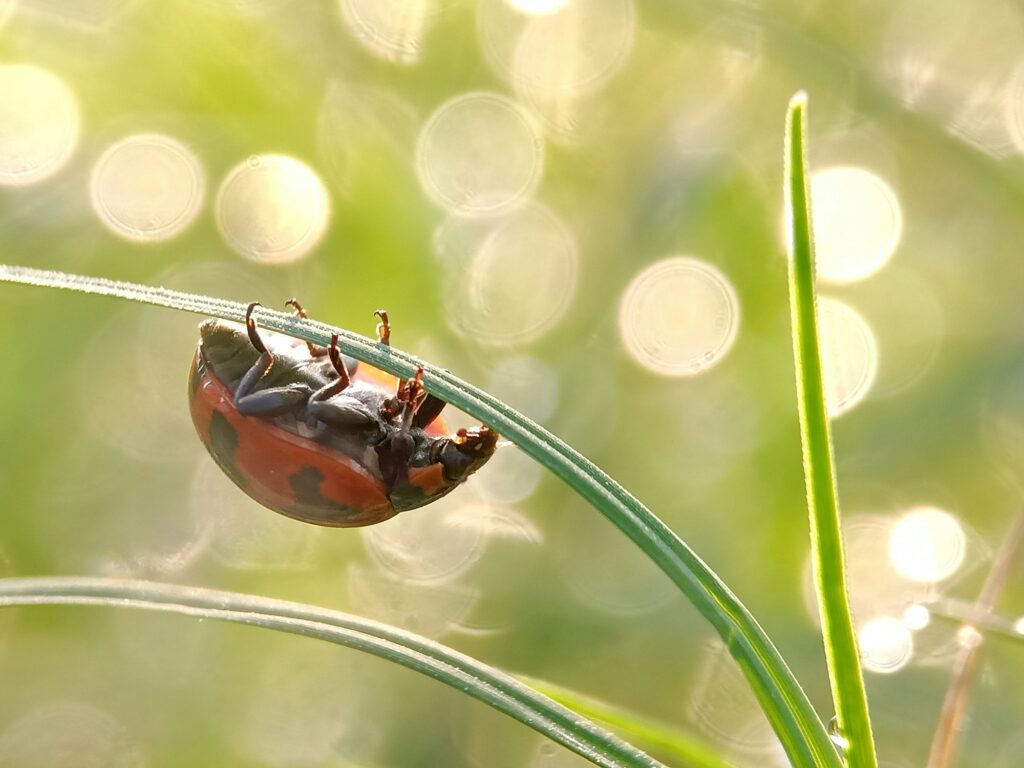
Guardians of the Garden: Embracing Natural Defenders
In the vibrant ecosystem of an organic cannabis garden, every leaf, stem, and root is part of a larger community, one that includes not just the plants we cherish but also a host of beneficial allies. These guardians, from insects to organic concoctions, play a pivotal role in keeping our green beauties healthy and happy.
The Tiny Heroes: Beneficial Insects
- Lacewings, Ladybugs, and Predatory Mites: These are the unsung heroes of the organic garden, eagerly feasting on aphids, spider mites, and other cannabis-consuming critters. Imagine them as the garden’s security team, always on patrol, ensuring peace and plant prosperity.
- Encouraging Diversity: Creating a garden that attracts these beneficial insects is like throwing a block party that everyone wants to attend. Companion planting with flowers like marigolds, lavender, and calendula not only adds beauty but also invites these natural protectors to stay, dine, and work in your cannabis garden.
The Gentle Warriors: Organic Pesticides and Fungicides
- Neem Oil: Extracted from the seeds of the neem tree, this versatile oil is like the Swiss Army knife of organic gardening. It tackles pests, fights fungus, and even deters some critters, all without harming beneficial insects or the environment.
- Essential Oils and Soap Sprays: A concoction of peppermint, eucalyptus, or rosemary oil mixed with a dash of soap and water can act as a refreshing yet effective deterrent against pests. It’s like a spa day gone wrong for any invaders, leaving your plants invigorated and pest-free.
The Organic Approach to Disease Management
- Prevention is Key: In the organic cannabis garden, a healthy plant is the best defense against disease. Ensuring optimal growing conditions—proper ventilation, adequate spacing, and balanced nutrition—keeps plants robust and less susceptible to attack.
- Bacillus subtilis and Trichoderma: These beneficial bacteria and fungi are the garden’s probiotics, outcompeting harmful pathogens and protecting plants from within. Applying them is akin to giving your plants a protective shield, armed with the best that nature has to offer.
Integrating Natural Defenses
- Companion Planting for Pest Management: Just as some plants attract beneficial insects, others can repel pests. Cultivating a diverse garden, where cannabis grows alongside pest-deterring plants, creates a natural barrier against many common threats.
- Regular Observation and Intervention: The most effective pest and disease management strategy is vigilant observation. Catching issues early and responding with targeted, natural remedies can prevent minor annoyances from becoming full-blown infestations.
Embracing natural pest and disease control isn’t just about safeguarding our cannabis plants; it’s about fostering an ecosystem where every living thing, from microbes to plants, coexists harmoniously. It’s a testament to working with nature to create a sustainable, thriving garden.
As we navigate our organic cannabis garden, we reach an essential aspect: efficient watering practices. In this lush sanctuary, every drop of water is vital, nourishing our plants and sustaining life. Let’s explore the art and science of wise watering, ensuring our cannabis receives the hydration it needs while respecting conservation and care principles.
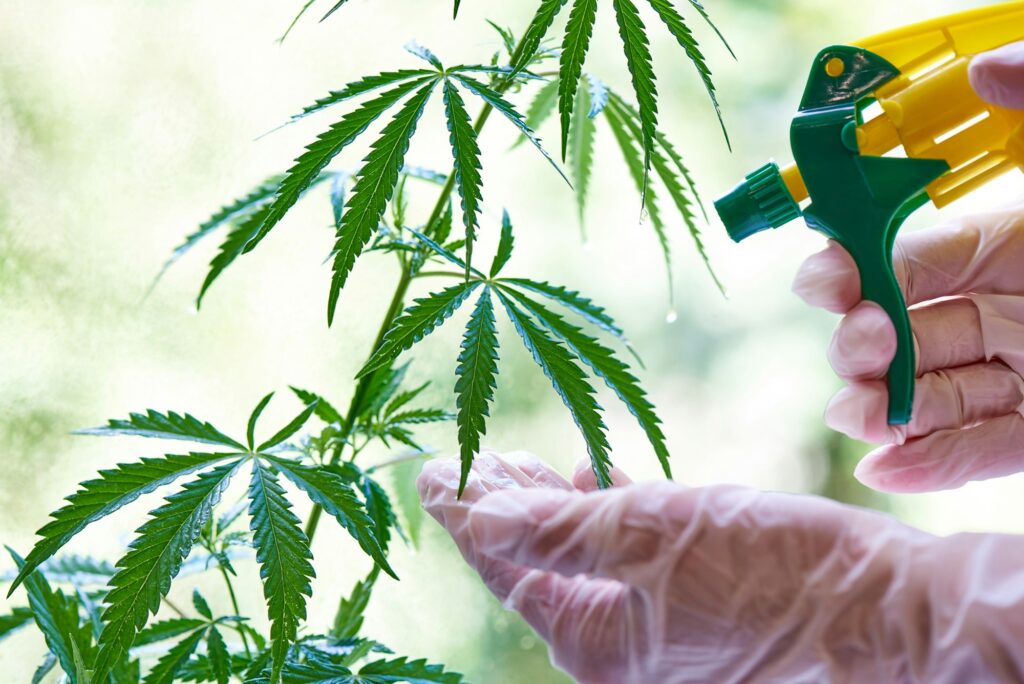
The Art of Watering Wisely in Organic Gardens
Water is the lifeblood of the garden, a vital element in the growth and health of our cannabis plants. Yet, in our quest to nurture, it’s easy to overlook the importance of how and when we provide this essential resource. Efficient watering practices not only conserve water but also prevent common issues such as overwatering and nutrient runoff, ensuring our organic gardens thrive sustainably.
Quality Water: The Pure Foundation
- Choosing the Right Water: In organic cultivation, the quality of water matters as much as the quality of the soil. Rainwater, naturally soft and free from chlorine and other municipal additives, is the gold standard. For those without access to rainwater, filtering tap water can remove unwanted chemicals, providing a clean slate for our plants.
- The Significance of pH: While on the topic of water quality, let’s not forget about pH. Even the purest water can disrupt the delicate balance of our living soil if its pH is out of sync with the garden’s needs. Aiming for a neutral pH or adjusting your water to match the soil’s natural range can enhance nutrient uptake and overall plant health.
Efficient Water Use: Techniques for Conservation
- Drip Irrigation and Soaker Hoses: These systems deliver water directly to the base of the plant, minimizing evaporation and waste. It’s like giving each plant a personalized water bottle, ensuring they stay hydrated without a drop going to waste.
- Mulching: A layer of organic mulch can be a game-changer, retaining soil moisture, regulating temperature, and reducing the need for frequent watering. It’s the garden’s natural insulation, keeping the soil’s thirst quenched longer.
Timing and Technique: When and How to Water
- The Early Bird Waters: Watering in the early morning reduces evaporation, allowing water to seep deeper into the soil and reach the roots more effectively. It’s like sneaking in a good drink before the sun’s rays start demanding their share.
- Deep, Infrequent Watering: Encouraging deep root growth is essential for healthy, resilient plants. By watering deeply but less frequently, we invite the roots to stretch further into the soil, seeking moisture. This practice not only strengthens the plant but also makes it more drought-tolerant.
Listening to Your Plants
- Observation is Key: Each plant has its way of saying, “I’m thirsty,” whether through slight droops or subtle changes in leaf color. Learning to read these signs allows us to water not just on a schedule, but as needed, tailoring our care to the garden’s rhythm.
- The Power of Patience: Before reaching for the hose or watering can, a simple check of the soil’s moisture can prevent overzealous watering. A finger dipped into the soil is often the best gauge, offering direct insight into what our plants are experiencing.
Embracing efficient watering practices in organic cannabis cultivation is an act of respect for our plants, resources, and the environment. By watering wisely, we not only nurture our cannabis plants but also promote sustainability, contributing to a healthier ecosystem.
As the growth cycle of our organic cannabis garden nears its end, the focus shifts to the final stages: harvesting and curing. These crucial steps are about more than just finishing the process; they’re about refining and perfecting the product. Proper harvesting and curing ensure that the cannabis retains its aromatic, potent, and pure qualities, reflecting the care and dedication invested throughout its growth. This attention to detail culminates in the highest quality cannabis, ready to be enjoyed at its best.

The Final Flourish: Harvesting and Curing Organic Cannabis
The Art of Timing: Knowing When to Harvest
- Observing the Signs: Like a chef knows exactly when to pull a dish from the oven, timing the harvest of cannabis is an art. The key indicators lie in the trichomes—the tiny, crystal-like structures on the buds that house the plant’s cannabinoids and terpenes. When these trichomes shift from clear to milky white, it’s nature’s way of saying, “We’re ready.”
- Patience Pays Off: Rushing to harvest can lead to less potent and flavorful buds. Waiting for the right moment ensures the highest levels of THC and CBD, alongside a richer, more complex terpene profile. It’s a lesson in patience, with a reward that’s well worth the wait.
Curing: The Secret to Unlocking Flavor and Potency
- Slow and Steady: Once harvested, the buds enter the curing phase, a critical period that can dramatically influence the final quality. Curing is not a race but a slow dance, allowing chlorophyll to break down and minimizing any harsh flavors while preserving the delicate terpenes that contribute to the cannabis’s aroma and taste.
- A Controlled Environment: The best curing takes place in a controlled environment—cool, dark, and with just the right amount of humidity. Jars are often used and opened periodically to allow for air exchange. This process, known as “burping,” helps prevent mold and encourages even curing.
The Result: A Symphony of Senses
- Enhanced Flavors and Aromas: Properly cured organic cannabis is a sensory delight, with pronounced flavors and aromas that reflect the natural terpene profile developed in the living soil.
- Smooth Experience: The meticulous curing process also leads to smoother smoke or vapor, making each session more enjoyable and less harsh on the throat.
- Potency Preserved: Beyond taste and smoothness, curing plays a crucial role in maintaining the potency of the cannabis, ensuring that the cannabinoids remain active and effective.
Beyond the Bud: The Impact of Harvest and Cure
- Respect for the Plant: The care taken in these final stages is a testament to the grower’s respect for the plant and its journey from seed to harvest. It’s the culmination of a relationship built on patience, understanding, and a deep connection to the cycle of growth.
- A Commitment to Quality: For the organic cannabis cultivator, harvesting and curing are not just steps in the process; they’re acts of dedication to quality, sustainability, and the purest expression of the plant’s potential.
Harvesting and curing organic cannabis are about much more than concluding the growth cycle; they’re about elevating the plant to its highest state. Through these careful, considered practices, we honor the effort and energy invested throughout the season, bringing to light a product that’s as rewarding to consume as it was to cultivate.
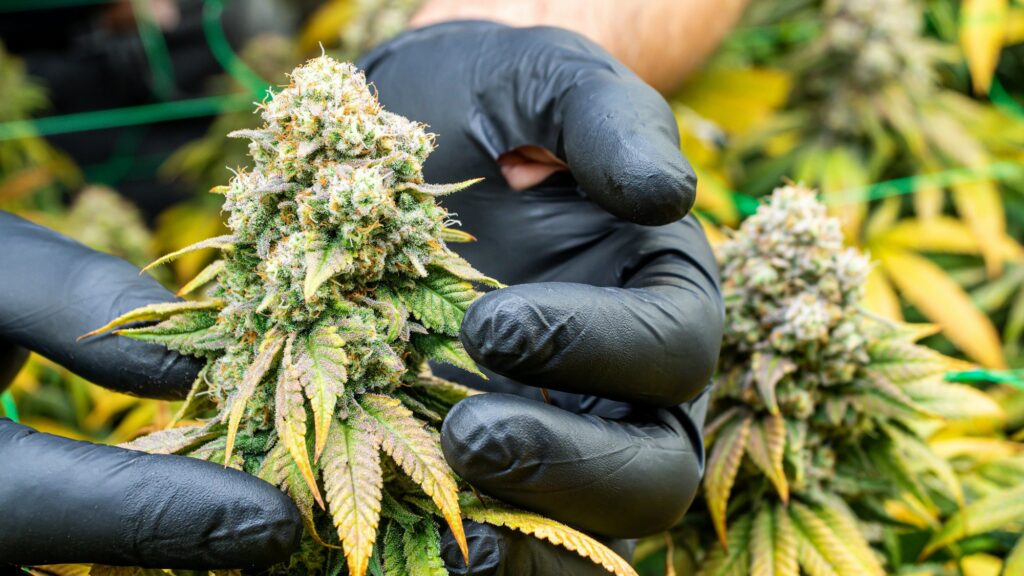
The Essence of Organic Cannabis: Purity, Potency, and Earth’s Flavor
Organic cannabis stands apart, not just as a choice but as a statement—a testament to the harmony between cultivation and nature. Here’s why enthusiasts and connoisseurs alike seek out organic cannabis, celebrating its special qualities.
Unmatched Flavor and Aroma: A Terpene Symphony
- The Soil’s Influence: The living soil used in organic cultivation is rich in nutrients and microorganisms, each contributing to the plant’s growth in unique ways. This diversity is mirrored in the plant’s terpene profile, which is significantly more complex and nuanced compared to conventionally grown cannabis. The result? A symphony of flavors and aromas that are as rich and varied as the soil they sprung from.
- Natural Nutrients, Natural Tastes: The use of natural fertilizers and amendments in organic growing contributes to the purity of flavor. Chemical residues, often found in non-organic products, can taint the taste and aroma of the buds. In contrast, organic cannabis offers a clean, unadulterated experience, allowing the true essence of the plant to shine through.
Health and Safety: The Peace of Mind Factor
- No Chemical Residues: Organic cannabis cultivation eschews synthetic pesticides and fertilizers, significantly reducing the risk of consuming harmful chemical residues. This peace of mind is invaluable, allowing users to enjoy their cannabis with confidence in its safety and purity.
- A Holistic Approach: The organic philosophy extends beyond the absence of chemicals, embracing a holistic approach to plant health. Strong, healthy plants are naturally more resistant to pests and diseases, further minimizing the need for interventions that could compromise the final product’s purity.
Environmental Stewardship: Cultivating with Consciousness
- Sustainable Practices: Organic cannabis cultivation is inherently aligned with sustainable practices. From preserving soil health and biodiversity to minimizing water use and avoiding pollutants, organic growers are stewards of the land, contributing to the health of the planet with every plant raised.
- Carbon Footprint Reduction: By avoiding synthetic inputs and often relying on local resources, organic cultivation methods can have a lower carbon footprint. This commitment to environmental sustainability adds another layer of value to organic cannabis, resonating with consumers who prioritize eco-conscious choices.
The Organic Cannabis Experience: Purity in Every Puff
- A Cleaner, More Enjoyable Experience: Many users report a distinctly cleaner and more enjoyable experience with organic cannabis. This can be attributed to the enhanced terpene profiles, the absence of harsh chemicals, and the overall quality of the product. Whether smoked, vaped, or infused into edibles, organic cannabis delivers a superior experience that is as close to nature as it gets.
- Market Demand and Appreciation: As awareness grows about the benefits of organic cultivation, so does the demand for organic cannabis products. Connoisseurs and casual consumers alike are willing to pay a premium for the peace of mind, environmental benefits, and superior quality that organic cannabis offers.
Organic cannabis cultivation is more than just a method; it’s a philosophy that values the plant, the consumer, and the environment. By choosing organic practices, we engage in a cycle of sustainability, enjoying cannabis in its purest form.
This approach highlights environmental stewardship by avoiding synthetic chemicals, enriching soil biodiversity, and promoting natural pest control. These practices benefit both the plants and the broader ecosystem, reducing environmental impact and fostering a healthier planet. Organic cultivation embodies a commitment to purity and sustainability, making each harvest a testament to environmental responsibility and a greener world.
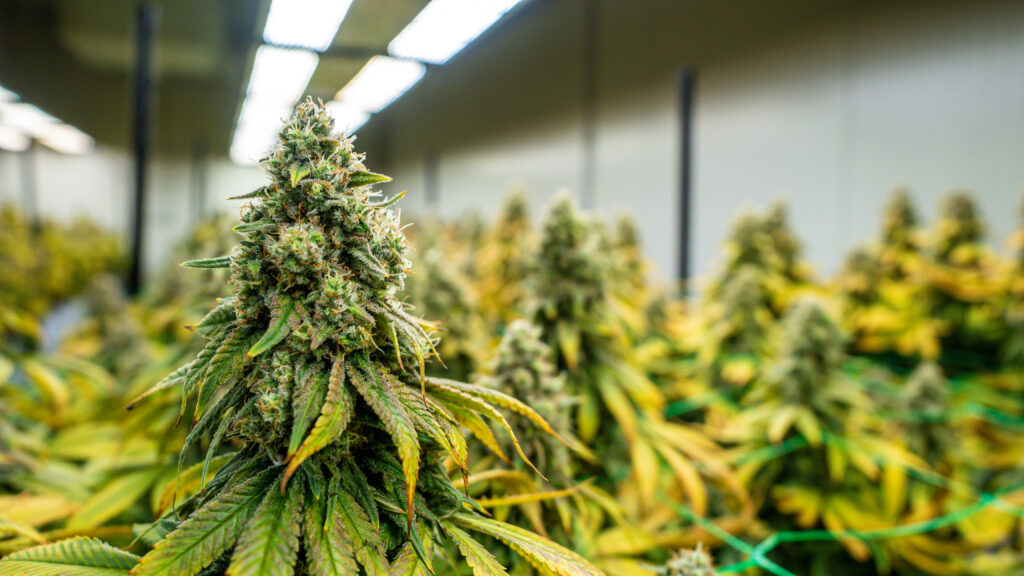
The Environmental Ethos of Organic Cannabis Cultivation
Organic cannabis cultivation emerges as a beacon of sustainability, illuminating a path that respects the earth and nurtures its resources. This method of cultivation is characterized by its minimal environmental footprint, promoting practices that replenish and restore the natural world.
Soil Health: The Foundation of Sustainability
- Living Soil: Organic cultivation revolves around the principle of living soil, teeming with microorganisms that play a critical role in nutrient cycling and soil structure. This approach fosters biodiversity below ground, which in turn supports a robust ecosystem above.
- No-Till Farming: By avoiding tilling, organic growers maintain soil structure, reduce erosion, and preserve carbon stocks. This practice underscores the commitment to reducing carbon emissions and combating climate change.
Water Conservation: A Drop in the Ocean
- Efficient Watering Practices: Organic cannabis growers employ methods such as drip irrigation and mulching to minimize water use and prevent wastage. These techniques ensure that every drop is used judiciously, reflecting a broader concern for the world’s precious water resources.
- Quality Over Quantity: The emphasis on water quality—free from chlorination and harmful additives—highlights the organic grower’s dedication to purity, not just in the product but in the resources used to nurture it.
Pesticides and Pollutants: Steering Clear of Synthetics
- Chemical-Free Cultivation: By eschewing synthetic pesticides, herbicides, and fertilizers, organic cannabis cultivation avoids contributing to runoff pollution that can harm aquatic ecosystems and degrade soil health.
- Beneficial Insects and Natural Remedies: The use of natural pest management strategies not only protects the cannabis plants but also safeguards local wildlife and insects, promoting a balance that enhances ecological resilience.
The Bigger Picture: Beyond the Garden
- Carbon Footprint: Organic cultivation practices, from composting to the use of renewable energy sources, demonstrate a commitment to reducing the carbon footprint associated with cannabis cultivation. It’s a holistic approach that considers the impact of every action on the global climate.
- Advocacy and Education: Organic cannabis growers often become vocal advocates for environmental issues, using their platform to educate others about the importance of sustainable practices in all aspects of life, extending the influence of their green ideals far beyond their gardens.
Cultivating a Greener Future
The environmental impact of organic cannabis cultivation is profound, offering a model for agriculture that prioritizes the health of the planet. It’s a testament to the possibility of producing high-quality cannabis while also contributing positively to the world around us.
Mastering organic cannabis cultivation is not just about achieving high-quality yields; it’s about fostering a sustainable and eco-friendly growing environment. By using natural inputs and sustainable practices, you can produce cleaner, tastier, and more potent cannabis while minimizing your environmental footprint. Organic cultivation emphasizes the importance of healthy soil, balanced nutrients, and natural pest control, all of which contribute to the overall well-being of your plants.
To deepen your understanding of the vital interactions between soil, roots, and nutrients, be sure to explore our comprehensive guide on The Rhizosphere. This article delves into the complex and fascinating world of the root-soil interface, highlighting how a healthy rhizosphere is crucial for nutrient uptake and overall plant health.
Additional Resources:
- Grow That Sh!t Better by Maximus Reigns – An essential eBook for both novice and experienced growers, offering advanced techniques and tips for improving cannabis cultivation.
- Cannabis Growers’ Handbook by Ed Rosenthal – A comprehensive guide that covers all aspects of growing cannabis, from setup to harvest.
- Royal Queen Seeds Blog – A rich resource for growers, featuring articles on growing techniques, strain information, and more.
- Need Cannabis Seeds? – Seedsman Seeds has a variety of seeds for all growers from new and seasoned to medical and CBD users.
- Grow Weed Easy – A website dedicated to providing step-by-step guides and resources for growing cannabis at home.
These resources provide a wealth of knowledge for growers interested in organic cannabis cultivation. By integrating these practices and focusing on the health of the rhizosphere, you can cultivate a thriving, sustainable garden that yields high-quality cannabis. Embrace the organic approach and enjoy the benefits of a cleaner, greener grow!
